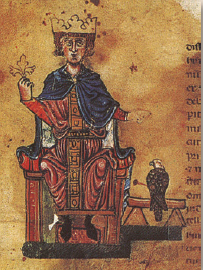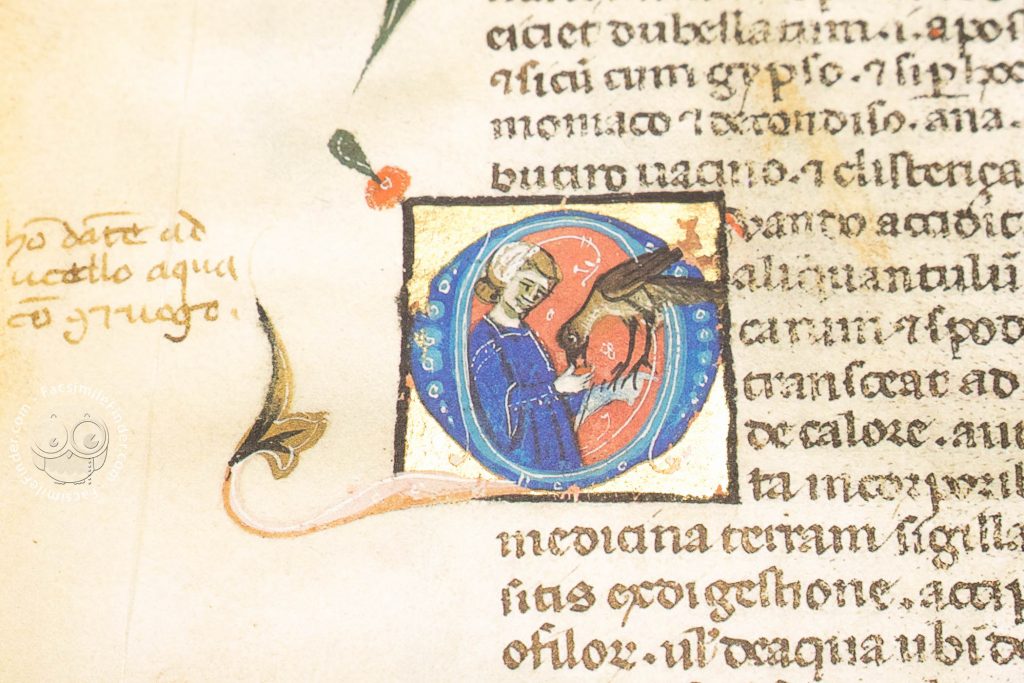The Vienna Moamyn, a true masterpiece, written in collaboration with Emperor Frederick II of Hohenstaufen, master of western falconry literature. Join us in the discovery of this medieval work of art and its outstanding quality.
Adeva has recently announced the publishing of the facsimile edition of the Vienna Moamyn (also known as De Scientia Venandi per Aves or Latin Moamin) as Vol. CXXIII of the “Codices Selecti” series, reproducing the manuscript – safely stored in Vienna, Kunsthistorisches Museum, Collections of Arms and Armour, K 4984 – in the original format and colors, in its most minute details.

The Vienna Moamyn was written and illuminated in the late 13th century, under request of Frederick II of Hohenstaufen (1194-1250), King of Sicily, playing a significant role for the creation of De Arte Venandi cum Avibus (“On the Art of Hunting with Birds”), which the king himself wrote a few years after.
Fifty-four folios with 101 masterly composed colorful genre scenes on the art of falconry – the Vienna Moamyn is a unique bibliophile treasure from the late medieval period that really deserves to be discovered.
With his famous treatise on falconry De Arte Venandi cum Avibus (“On the Art of Hunting with Birds”), Frederick II of Hohenstaufen wrote a groundbreaking work about falconry in order to preserve a more than two-thousand-year old cultural technique from the Central Asian and Arabian realms for the Western world. Based on Arabic sources, his own intensive studies about the anatomy, life, and learning patterns of birds of prey, and De Scientia Venandi per Aves – currently known as the Vienna Moamyn – he compiled a monumental treatise, which in its factual and systematic presentation is unmatched in the 13th century and still highly significant for falconry today.

Written in Latin, the Vienna Moamyn is a five-volume treatise on falconry and the keeping of hounds, which deals with all aspects of hunting with birds and dogs. Book 1 provides in-depth knowledge about birds of prey and the difficult process of training them, while Books 2 and 3 are dedicated to various avian diseases and proven healing methods. Books 4 and 5 deal with the correct husbandry and care of hounds.
The artist used an amazing range of expression to meet the challenge of illustrating the scientific text. In the more than 80 scenes in Books 2 and 3, no two depictions are the same – although the falconer and his birds are the only protagonists to be seen. In the last two volumes, hounds were added to enrich the iconographic program. The naturalistic reproduction of their habitus and behavior, the illustration of the emotional relationship between the falconer and his birds, and the perfect insertion of the scenes in the letter bodies bear testimony to the great talent of the illuminator who turned each of these little pictures into a work of art in its own right.
Adeva has produced two formats: regular edition and luxury edition, both provided with a commentary volume authored by Baudouin Van de Abeele, the world-renowned expert for medieval hunting treatises.
A special feature worth mentioning are the notes in the margins of the miniatures, in Italian. Rather than being later additions, these annotations served as exact instructions for the artist about the contents of the scenes intended for those parts of the initials that the scribe had left blank for him. A similar number of painting instructions is hardly found in any other medieval manuscript. This makes the Vienna Moamyn an outstanding object of research into the relationship between picture and text.

Adeva published the Vienna Moamyn facsimile in two editions:
- the luxury edition (99 copies), in which all 101 initials and all gilded parts are reproduced using 23 carat gold and partly chiselled. It features a replica of the original binding in green patterned velvet, clasps faithful to the original, book block hand-sewn onto 4 raised band, handsewn headbands and tailbands. The facsimile comes in a boxed set together with the commentary volume;
- the regular edition (381 copies), in which all gilded parts are reproduced using faithfully colored foil gold and chiselling. It features a replica of the original binding in green patterned velvet, book block thread-stitched by hand, hand-sewn head-bands and tailbands. The facsimile edition is preserved in a slipcase.
The commentary volume to go with the facsimile edition is authored by Baudouin Van de Abeele. The world-renowned expert for medieval hunting treatises is professor of medieval sciences at the Université catholique de Louvain, head of the Centre d’études sur le Moyen Age et la Renaissance (UCL), and editor of the series Bibliotheca cynegetica (Droz).
Subscribe to Our Newsletter
If you want to know more about the latest news and events on facsimile editions subscribe to our newsletter!

